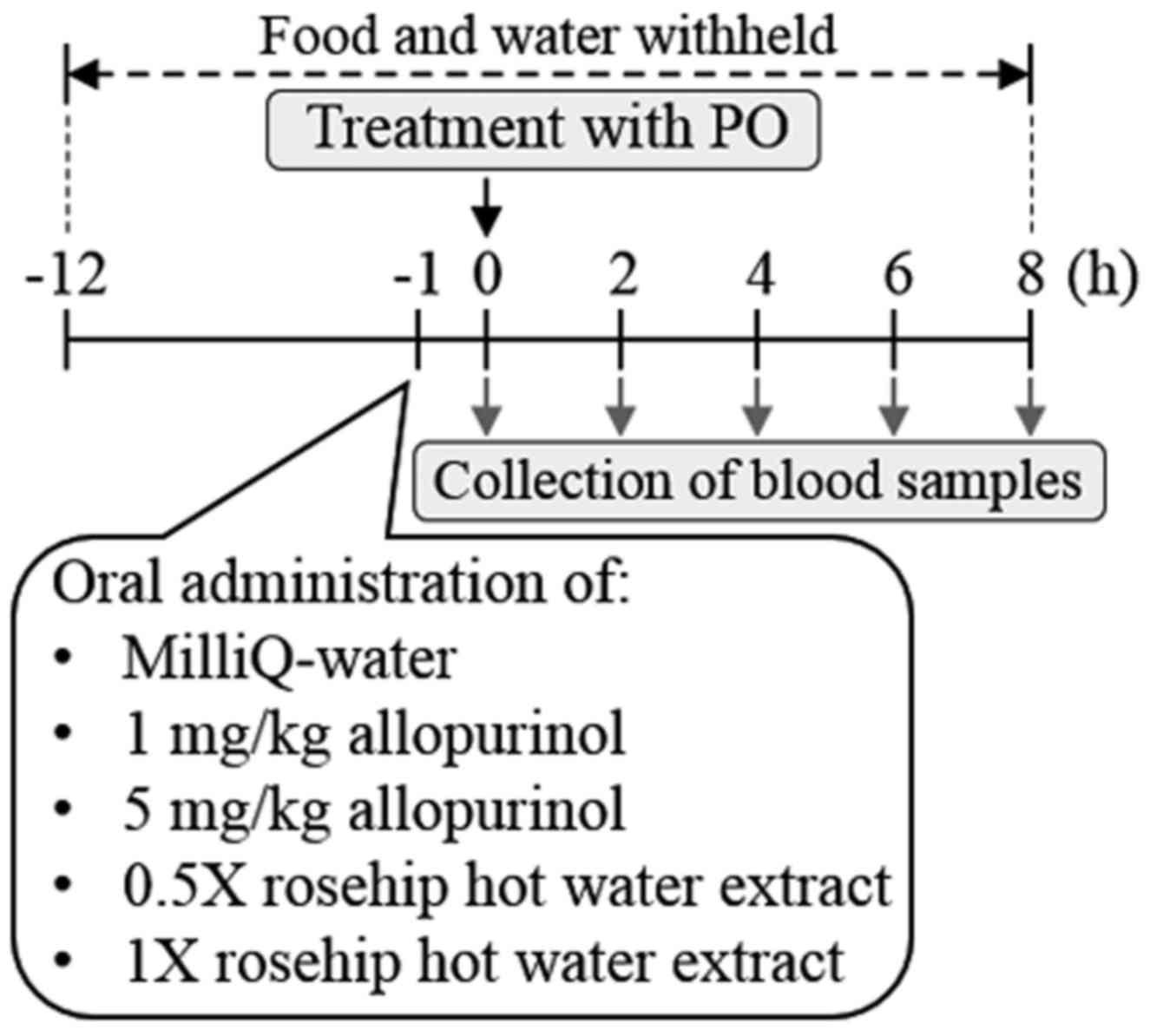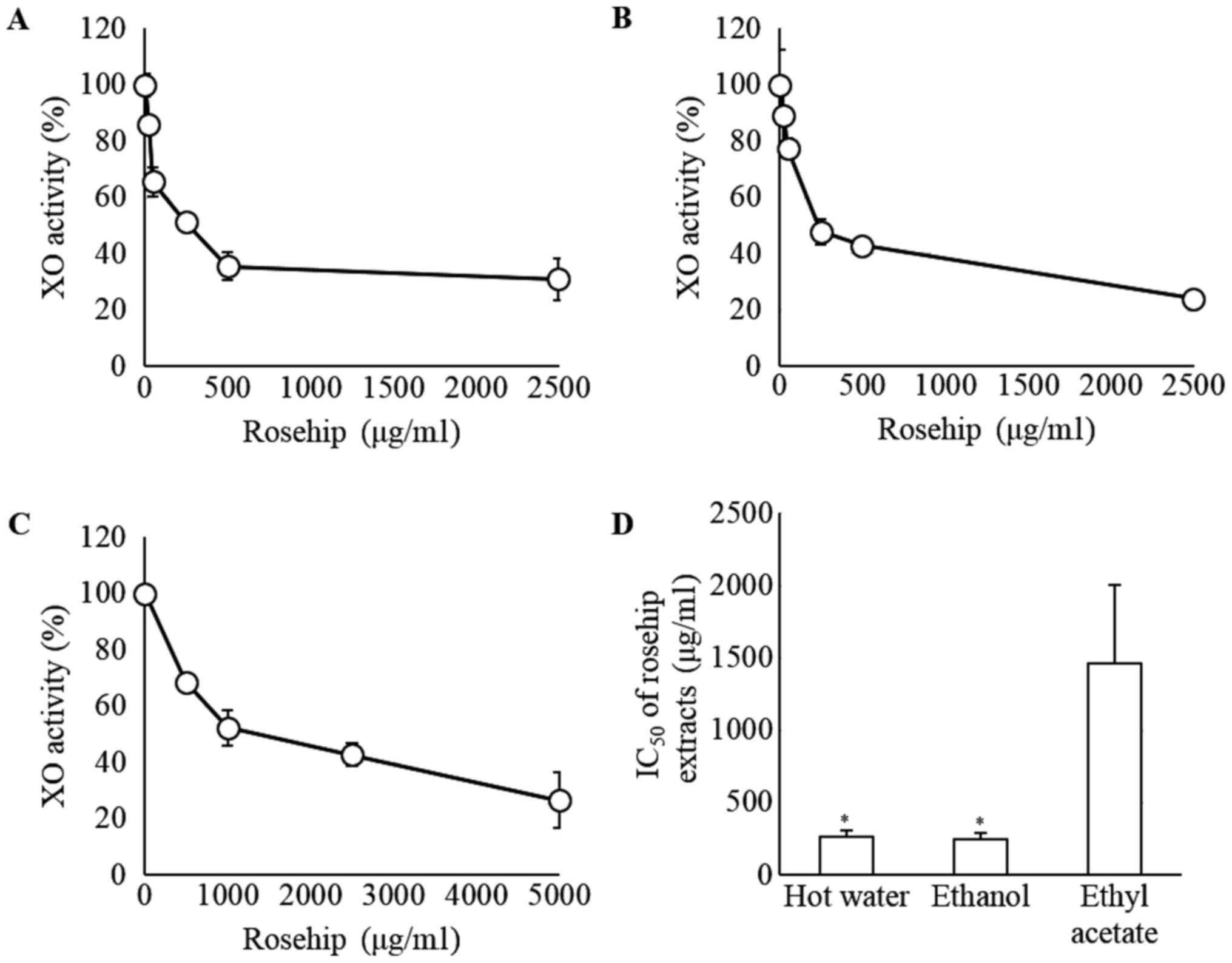|
1
|
Galland L: Functional Foods: Health
Effects and Clinical Applications. Elsevier Ltd.; pp. 366–371.
2013
|
|
2
|
World Health Organization (WHO): The role
of the pharmacist in self-care and self-medication. WHO; Geneva:
pp. 151998
|
|
3
|
Kikuchi H, Yuan B, Yuhara E, Imai M,
Furutani R, Fukushima S, Hazama S, Hirobe C, Ohyama K, Takagi N, et
al: Involvement of histone H3 phosphorylation via the activation of
p38 MAPK pathway and intracellular redox status in cytotoxicity of
HL-60 cells induced by Vitex agnus-castus fruit extract. Int J
Oncol. 45:843–852. 2014.PubMed/NCBI
|
|
4
|
Kikuchi H, Yuan B, Yuhara E, Takagi N and
Toyoda H: Involvement of histone H3 phosphorylation through p38
MAPK pathway activation in casticin-induced cytocidal effects
against the human promyelocytic cell line HL-60. Int J Oncol.
43:2046–2056. 2013.PubMed/NCBI
|
|
5
|
Kikuchi H, Yuan B, Nishimura Y, Imai M,
Furutani R, Kamoi S, Seno M, Fukushima S, Hazama S, Hirobe C, et
al: Cytotoxicity of Vitex agnus-castus fruit extract and its major
component, casticin, correlates with differentiation status in
leukemia cell lines. Int J Oncol. 43:1976–1984. 2013.PubMed/NCBI
|
|
6
|
Imai M, Kikuchi H, Yuan B, et al: Enhanced
growth inhibitory effect of 5-fluorouracil in combination with
Vitex agnus-castus fruits extract against a human colon
adenocarcinoma cell line, COLO 201. J Chin Clin Med. 6:14–19.
2011.
|
|
7
|
Imai M, Yuan B, Kikuchi H, Saito M, Ohyama
K, Hirobe C, Oshima T, Hosoya T, Morita H and Toyoda H: Growth
inhibition of a human colon carcinoma cell, COLO 201, by a natural
product, Vitex agnus-castus fruits extract, in vivo and in vitro.
Adv Biol Chem. 2:20–28. 2012. View Article : Google Scholar
|
|
8
|
Yuan B, Imai M, Kikuchi H, et al:
Cytocidal Effects of Polyphenolic Compounds, Alone or in
Combination with, Anticancer Drugs Against Cancer Cells: Potential
Future Application of the Combinatory TherapyApoptosis and
Medicine. Ntuli T: InTech; Croatia: pp. 155–174. 2012
|
|
9
|
Ohno H, Miyoshi S, Araho D, et al:
Efficient utilization of licorice root by alkaline extractionVivo.
28. Brooklyn; pp. 785–794. 2014
|
|
10
|
Sunaga K, Ohkawa K, Nakamura K, Ohkubo A,
Harada S and Tsuda T: Mechanism-based inhibition of recombinant
human cytochrome P450 3A4 by tomato juice extract. Biol Pharm Bull.
35:329–334. 2012. View Article : Google Scholar : PubMed/NCBI
|
|
11
|
Imai M, Kikuchi H, Denda T, Ohyama K,
Hirobe C and Toyoda H: Cytotoxic effects of flavonoids against a
human colon cancer derived cell line, COLO 201: A potential natural
anti-cancer substance. Cancer Lett. 276:74–80. 2009. View Article : Google Scholar : PubMed/NCBI
|
|
12
|
Sugaya E, Jin W, Sugaya A, Sunaga K and
Tsuda T: Inhibitory effects of peony root extract on the large
conductance calcium-activated potassium current essential in
production of bursting activity. J Herb Pharmacother. 6:65–77.
2006. View Article : Google Scholar : PubMed/NCBI
|
|
13
|
Sunaga K, Sugaya E, Kajiwara K, Tsuda T,
Sugaya A and Kimura M: Molecular mechanism of preventive effect of
peony root extract on neuron damage. J Herb Pharmacother. 4:9–20.
2004. View Article : Google Scholar : PubMed/NCBI
|
|
14
|
Demir F and Özcan M: Chemical and
technological properties of rose (Rosa canina L.) fruits grown wild
in Turkey. J Food Eng. 47:333–336. 2001. View Article : Google Scholar
|
|
15
|
Ziegler SJ, Meier B and Sticher O: Fast
and Selective Assay of l-Ascorbic Acid in Rose Hips by RP-HPLC
Coupled with Electrochemical and/or Spectrophotometric Detection.
Planta Med. 52:383–387. 1986. View Article : Google Scholar
|
|
16
|
Chrubasik C, Duke RK and Chrubasik S: The
evidence for clinical efficacy of rose hip and seed: A systematic
review. Phytother Res. 20:1–3. 2006. View
Article : Google Scholar : PubMed/NCBI
|
|
17
|
Orhan N, Aslan M, Hosbas S and Orhan
Deliorman D: Antidiabetic Effect and Antioxidant Potential of Rosa
canina Fruits. Pharmacogn Mag. 5:309–315. 2009. View Article : Google Scholar
|
|
18
|
Gao X, Björk L, Trajkovski V and Uggla M:
Evaluation of antioxidant activities of rosehip ethanol extracts in
different test systems. J Sci Food Agric. 80:2021–2027. 2000.
View Article : Google Scholar
|
|
19
|
Christensen LP: Galactolipids as potential
health promoting compounds in vegetable foods. Recent Pat Food Nutr
Agric. 1:50–58. 2009. View Article : Google Scholar : PubMed/NCBI
|
|
20
|
Orhan Deliorman D, Hartevioğlu A, Küpeli E
and Yesilada E: In vivo anti-inflammatory and antinociceptive
activity of the crude extract and fractions from Rosa canina
L. fruits. J Ethnopharmacol. 112:394–400. 2007. View Article : Google Scholar : PubMed/NCBI
|
|
21
|
Jäger AK, Petersen KN, Thomasen G and
Christensen SB: Isolation of linoleic and α-linolenic acids as
COX-1 and −2 inhibitors in rose hip. Phytother Res. 22:982–984.
2008. View
Article : Google Scholar : PubMed/NCBI
|
|
22
|
Jäger AK, Eldeen IMS and van Staden J:
COX-1 and −2 activity of rose hip. Phytother Res. 21:1251–1252.
2007. View
Article : Google Scholar : PubMed/NCBI
|
|
23
|
Sadeghi H, Hosseinzadeh S, Touri
Akbartabar M, Ghavamzadeh M, Barmak Jafari M, Sayahi M and Sadeghi
H: Hepatoprotective effect of Rosa canina fruit extract against
carbon tetrachloride induced hepatotoxicity in rat. Avicenna J
Phytomed. 6:181–188. 2016.PubMed/NCBI
|
|
24
|
Ninomiya K, Matsuda H, Kubo M, Morikawa T,
Nishida N and Yoshikawa M: Potent anti-obese principle from Rosa
canina: Structural requirements and mode of action of
trans-tiliroside. Bioorg Med Chem Lett. 17:3059–3064. 2007.
View Article : Google Scholar : PubMed/NCBI
|
|
25
|
Wu XW, Muzny DM, Lee CC and Caskey CT: Two
independent mutational events in the loss of urate oxidase during
hominoid evolution. J Mol Evol. 34:78–84. 1992. View Article : Google Scholar : PubMed/NCBI
|
|
26
|
Lombardi R, Pisano G and Fargion S: Role
of serum uric acid and ferritin in the development and progression
of NAFLD. Int J Mol Sci. 17:5482016. View Article : Google Scholar : PubMed/NCBI
|
|
27
|
Shekarriz B and Stoller ML: Uric acid
nephrolithiasis: Current concepts and controversies. J Urol.
168:1307–1314. 2002. View Article : Google Scholar : PubMed/NCBI
|
|
28
|
Edwards NL: The role of hyperuricemia in
vascular disorders. Curr Opin Rheumatol. 21:132–137. 2009.
View Article : Google Scholar : PubMed/NCBI
|
|
29
|
Feig DI, Kang DH and Johnson RJ: Uric acid
and cardiovascular risk. N Engl J Med. 359:1811–1821. 2008.
View Article : Google Scholar : PubMed/NCBI
|
|
30
|
Nguyen MTT, Awale S, Tezuka Y, Shi L,
Zaidi SF, Ueda JY, Tran QL, Murakami Y, Matsumoto K and Kadota S:
Hypouricemic effects of acacetin and 4,5-o-dicaffeoylquinic acid
methyl ester on serum uric acid levels in potassium
oxonate-pretreated rats. Biol Pharm Bull. 28:2231–2234. 2005.
View Article : Google Scholar : PubMed/NCBI
|
|
31
|
Zhao X, Zhu JX, Mo SF, Pan Y and Kong LD:
Effects of cassia oil on serum and hepatic uric acid levels in
oxonate-induced mice and xanthine dehydrogenase and xanthine
oxidase activities in mouse liver. J Ethnopharmacol. 103:357–365.
2006. View Article : Google Scholar : PubMed/NCBI
|
|
32
|
Fridovich I: The Competitive Inhibition of
Uricase by Oxonate and by Related Derivatives of s-Triazines. J
Biol Chem. 240:2491–2494. 1965.PubMed/NCBI
|
|
33
|
Ichida K, Matsuo H, Takada T, Nakayama A,
Murakami K, Shimizu T, Yamanashi Y, Kasuga H, Nakashima H, Nakamura
T, et al: Decreased extra-renal urate excretion is a common cause
of hyperuricemia. Nat Commun. 3:7642012. View Article : Google Scholar : PubMed/NCBI
|
|
34
|
Michalets EL: Update: Clinically
significant cytochrome P-450 drug interactions. Pharmacotherapy.
18:84–112. 1998.PubMed/NCBI
|
|
35
|
Foster BC, Vandenhoek S, Hana J, Krantis
A, Akhtar MH, Bryan M, Budzinski JW, Ramputh A and Arnason JT: In
vitro inhibition of human cytochrome P450-mediated metabolism of
marker substrates by natural products. Phytomedicine. 10:334–342.
2003. View Article : Google Scholar : PubMed/NCBI
|
|
36
|
Fujita T, Kawase A, Niwa T, Tomohiro N,
Masuda M, Matsuda H and Iwaki M: Comparative evaluation of 12
immature citrus fruit extracts for the inhibition of cytochrome
P450 isoform activities. Biol Pharm Bull. 31:925–930. 2008.
View Article : Google Scholar : PubMed/NCBI
|
|
37
|
Sand PG, Dreiseitel A, Stang M, Schreier
P, Oehme A, Locher S and Hajak G: Cytochrome P450 2C19 inhibitory
activity of common berry constituents. Phytother Res. 24:304–307.
2010.PubMed/NCBI
|
|
38
|
Kimura Y, Ito H and Hatano T: Effects of
mace and nutmeg on human cytochrome P450 3A4 and 2C9 activity. Biol
Pharm Bull. 33:1977–1982. 2010. View Article : Google Scholar : PubMed/NCBI
|
|
39
|
Kim H, Yoon YJ, Shon JH, Cha IJ, Shin JG
and Liu KH: Inhibitory effects of fruit juices on CYP3A activity.
Drug Metab Dispos. 34:521–523. 2006. View Article : Google Scholar : PubMed/NCBI
|
|
40
|
Ishibuchi S, Morimoto H, Oe T, Ikebe T,
Inoue H, Fukunari A, Kamezawa M, Yamada I and Naka Y: Synthesis and
structure-activity relationships of 1-phenylpyrazoles as xanthine
oxidase inhibitors. Bioorg Med Chem Lett. 11:879–882. 2001.
View Article : Google Scholar : PubMed/NCBI
|
|
41
|
Tian F, Li B, Ji B, Yang J, Zhang G, Chen
Y and Luo Y: Antioxidant and antimicrobial activities of
consecutive extracts from Galla chinensis: The polarity affects the
bioactivities. Food Chem. 113:173–179. 2009. View Article : Google Scholar
|
|
42
|
Miraj S: Phytochemical composition and in
vitro pharmacological activity of rose hip (Rosa canina L.).
Pharmachem. 8:117–122. 2016.
|
|
43
|
Owen PL and Johns T: Xanthine oxidase
inhibitory activity of northeastern North American plant remedies
used for gout. J Ethnopharmacol. 64:149–160. 1999. View Article : Google Scholar : PubMed/NCBI
|
|
44
|
Umamaheswari M, AsokKumar K, Somasundaram
A, Sivashanmugam T, Subhadradevi V and Ravi TK: Xanthine oxidase
inhibitory activity of some Indian medical plants. J
Ethnopharmacol. 109:547–551. 2007. View Article : Google Scholar : PubMed/NCBI
|
|
45
|
Nana FW, Hilou A, Millogo JF and Nacoulma
OG: Phytochemical composition, antioxidant and xanthine oxidase
inhibitory activities of Amaranthus cruentus L. and
Amaranthus hybridus L. Extracts. Pharmaceuticals (Basel).
5:613–628. 2012. View Article : Google Scholar : PubMed/NCBI
|
|
46
|
Ozyürek M, Bektaşoğlu B, Güçlü K and Apak
R: Measurement of xanthine oxidase inhibition activity of phenolics
and flavonoids with a modified cupric reducing antioxidant capacity
(CUPRAC) method. Anal Chim Acta. 636:42–50. 2009. View Article : Google Scholar : PubMed/NCBI
|
|
47
|
Kılıçgün H and Altıner D: Correlation
between antioxidant effect mechanisms and polyphenol content of
Rosa canina. Pharmacogn Mag. 6:238–241. 2010. View Article : Google Scholar : PubMed/NCBI
|
|
48
|
Guengerich FP: Role of cytochrome P450
enzymes in drug-drug interactions. Adv Pharmacol. 43:7–35. 1997.
View Article : Google Scholar : PubMed/NCBI
|
|
49
|
Christensen R, Bartels EM, Altman RD,
Astrup A and Bliddal H: Does the hip powder of Rosa canina
(rosehip) reduce pain in osteoarthritis patients? - a meta-analysis
of randomized controlled trials. Osteoarthritis Cartilage.
16:965–972. 2008. View Article : Google Scholar : PubMed/NCBI
|
|
50
|
Rossnagel K, Roll S and Willich SN: The
clinical effectiveness of rosehip powder in patients with
osteoarthritis. A systematic review. MMW Fortschr Med. 149:51–56.
2007.(In German). PubMed/NCBI
|
|
51
|
Cohen M: Rosehip - an evidence based
herbal medicine for inflammation and arthritis. Aust Fam Physician.
41:495–498. 2012.PubMed/NCBI
|















